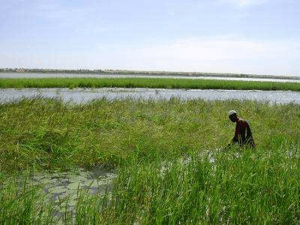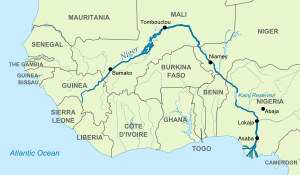African rice facts for kids
Quick facts for kids African rice |
|
|---|---|
 |
|
| Seeds of Oryza glaberrima | |
| Scientific classification | |
| Genus: |
Oryza
|
| Species: |
glaberrima
|
 |
|
| The range of wild Oryza glaberrima. The plant is cultivated outside its wild range. | |
Oryza glaberrima, also known as African rice, is one of the two main types of rice grown by people. It was first grown in West Africa about 3,000 years ago. Today, you don't see it as much in West African markets because other types of rice from Asia have become more popular.
Even though Asian rice often produces more grain, African rice is still important. It makes up about 20% of the rice grown in West Africa. African rice is special because it's tough and can grow in many different conditions. It resists pests and doesn't need as much work to grow. People also love its unique nutty flavor. For some, like the Jola people who follow Awasena (a traditional African religion), African rice is even sacred. It's also a special old type of rice grown in the United States.
It's usually hard to mix African rice with Asian rice to create new types. But some successful mixes do exist.
Contents
The Story of African Rice
Scientists believe that people in different parts of the world started growing rice plants on their own. African rice is very similar to a wild African rice called Oryza barthii. In the same way, Asian rice (Oryza sativa) is similar to a wild Asian rice. These two main types of rice are quite different from each other genetically.
Oryza barthii still grows wild in Africa today. Long ago, the Sahara desert was much wetter, with huge lakes. As the climate became drier, the wild rice started to rely more on humans for water. This likely led to people growing it more and more. Some rice that grew in deeper water became "floating rice," which can grow very tall.
African rice was first grown about 3,000 years ago. This happened in the delta of the Upper Niger River, in what is now Mali. From there, it spread across West Africa. It has also been found on the east coast of Africa, near Zanzibar.
Wild rice plants often drop their seeds easily when they are ripe. This is called "shattering." But African rice (O. glaberrima) doesn't shatter as much. This makes it easier for farmers to collect the grains.

In the late 1400s and 1500s, Portuguese sailors visited West Africa. They wrote about how rich the land was with rice fields. They described "vast crops" and "large fields planted in rice." The Portuguese mentioned groups like the Jola people, Landuma, Biafada, and Bainik growing rice. They also wrote about the dike systems used to grow rice. These old systems are similar to the ones still used in West Africa today.
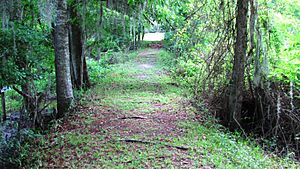
African rice seeds and the knowledge to grow them were brought to the Americas. This happened with the transatlantic slave trade, starting around the 1550s in Brazil and 1784 in the U.S. The seeds were carried on ships as food. Enslaved people, who were skilled rice farmers, brought their knowledge with them. Their skills were very valuable because rice was a high-priced crop. African rice could grow in salty water, so it was perfect for coastal areas, just like in West Africa.
There are many stories about how African rice came to North America. One story tells of an enslaved woman who hid grains in her hair. African rice is now rare in places like Brazil and Panama, but it is still sometimes grown there.
Asian rice arrived in West Africa in the late 1800s. By the late 1900s, it had largely replaced African rice. However, African rice is still grown in certain areas, especially where conditions are difficult. Farmers often prefer its taste. Some farmers grow African rice for their families to eat and Asian rice to sell, as African rice is not usually exported.
In 2007, food prices went up, which made people want to grow more rice. Many African regions that grow rice still have to buy rice from other countries. To help with this, new types of rice called NERICA (New Rice for Africa) were created. These are mixes of African and Asian rice. They were developed in the 1990s and released in the early 2000s. NERICA varieties are not always as tough as African rice and can need more work.
How African Rice is Used
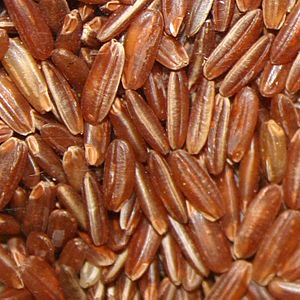
The same rice, after the husk is removed (whole brown rice)
|
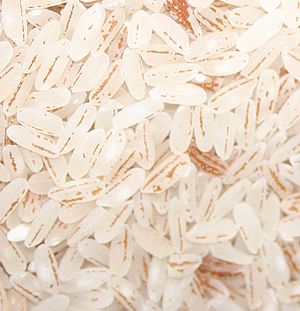
The same rice, after most of the outer layers are removed to make white rice
|
Farmers often grow several types of African rice. This helps them harvest the rice at different times. Freshly harvested rice is moist. It can be puffed over a fire and eaten right away. When fried, African rice often turns brownish. This is because of its green husk, which changes color when heated.
You can cook African rice much like Asian rice. But it has a special nutty flavor that people in West Africa really like. African rice grains are often reddish. Some types smell very nice, while others, like Carolina Gold, have no smell at all.
African rice is also used in traditional medicine.
Special Qualities of African Rice
Farmers in West Africa are slowly replacing O. glaberrima with O. sativa (Asian rice). But African rice has many unique traits.
What it Looks Like
African rice plants are usually tall, often under 120 centimeters (about 4 feet). But some "floating" types can grow up to five meters (about 16 feet) tall! These tall types can also grow branches and roots from higher up on their stems. Generally, African rice has small, pear-shaped grains. Its outer layers (bran) are reddish, and its husks can be green to black. It has straight, simple flower clusters and short, rounded parts called ligules. Sometimes, it can be hard to tell African rice from Asian rice just by looking. To be sure, you might need a genetic test.
Grain Qualities
The grains of African rice are a bit brittle, meaning they can break easily.
Hardiness
African rice is very good at growing in the African environment. It can handle dry spells and deep water. It also tolerates changes in water levels, bad soil, tough weather, and even a bit of neglect better than Asian rice. Some types grow faster. They can be planted directly in the ground, so farmers don't need to move young plants. Most African rice grows with rainwater, and the soil is often not plowed.
African rice grows a lot of leaves and stems. This helps it smother weeds, so fewer weeds grow around it. It is also better at fighting off many rice pests and diseases. These include blast disease, African rice gall midge, tiny worms called nematodes, and certain viruses. It also resists a harmful plant called Striga.
Yield and Processing
African rice grains tend to "shatter" more than Asian rice. This means more grains fall off the plant before harvest. This is one reason why African rice often has a lower yield. If farmers put bags around the rice heads before they are ripe, they can catch the shattered grains. When they do this, African rice can produce as much as Asian rice.
Like other grains, rice plants can fall over when their grain heads are full. This is called "lodging." African rice is taller and has weaker stems, so it is more likely to lodge. However, its height also helps it survive in deep water and makes it easier to harvest by hand.
The grains of African rice are more brittle than Asian rice. This means they are more likely to break when processed in factories. Broken rice is popular in West Africa. But most of the broken rice eaten there comes from Asian rice.
Scientists have studied the genes of O. glaberrima. This helps them compare it to other rice types and understand how certain genes work.
Breeding New Types
African and Asian rice don't easily mix, even when scientists try to cross them. When they do, the new plants are usually not able to have babies (they are infertile). Even if they are fertile, they don't produce many offspring.
However, some successful mixes have happened naturally in one area of Guinea.
More recently, new types of rice called NERICA (new rice for Africa) have been created. These are special mixes of African and Asian rice. Scientists made over 3,000 different crosses to create NERICA. It's easier to breed new types within African rice itself. There are countless varieties of African rice, though many may have been lost over time. Similar mixed varieties have also been created in the United States and with Indian rice types.
Types of African Rice
African Varieties
There are many different types of African rice. In the 1960s, older women in a village called Jipalom could easily name more than ten types of African rice that were no longer grown. They also knew the half-dozen types still being planted. Each woman would plant several different types. This helped them suit different small areas of land and harvest at different times. A survey in 2006 showed that a village typically grew 25 types of rice. An average family would have 14 types and grow four each year. This is fewer than in past decades. Women, who traditionally care for the seeds, often trade them with people far away.
Some general types, each with smaller groups, include:
- aspera
- ebenicolorata
- evoluta
- rigida
- rustica
Scientists at the Africa Rice Center have found two types, TOG 12303 and TOG 9300, that don't shatter much. This means they can produce as much rice as Asian varieties that don't shatter.
The Africa Rice Center also successfully mixed African rice with Asian rice to create the New Rice for Africa (NERICA) group of rice types.
American Varieties
Carolina Gold is an old type of rice grown in the early United States. It's sometimes called "golden-seed rice" because of the color of its grains.
A type of long-grain gold-seed rice, with grains about 1.2 centimeters (0.4 inches) long, became popular in the 1840s. But this type was lost during the American Civil War.
Charleston Gold was released in 2011. It's a mix of Carolina Gold and two types of Oryza sativa (Asian rice). This new type produces more rice, has a shorter stem, and has a nice smell.
Images for kids
-
Dikes protect the rice paddy fields from saltwater. Farmers use the freshwater layer from high tides for irrigation. Similar farming methods have been used in Karabane, Senegal, since at least the 1400s.
-
A similar dike at Hampton Plantation in Charleston County, South Carolina, United States, in 2010. This one is now abandoned and covered by trees.
See also
 In Spanish: Arroz africano para niños
In Spanish: Arroz africano para niños


